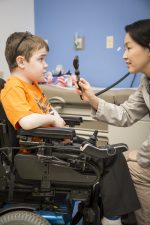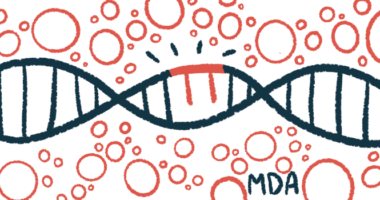Large1 Gene Helps MD Mice Live Longer by Restoring Muscle Function
Gene therapy shows benefits for severe congenital muscular dystrophy

Transferring a healthy version of the Large1 gene into adult mice with severe congenital muscular dystrophy restored the function of muscles involved in movement and breathing, a study found.
The use of this gene therapy translated into an extended lifespan for the mice, which had congenital muscular dystrophy — a group of genetic diseases known as CMD and characterized by muscle wasting that’s typically evident at birth — due to a Large1 mutation.
The findings provide evidence that “features of muscular dystrophy are treatable, even after severe muscle degeneration is established,” the researchers wrote.
The study, “Large1 gene transfer in older myd mice with severe muscular dystrophy restores muscle function and greatly improves survival,” was published in the journal Science Advances.
Gene therapies are being used by some researchers as potential strategies to correct disease-causing mutations. They work by repairing (editing) or silencing the faulty gene, or by transferring a healthy version of it into cells. In studies of muscular dystrophy, the therapy is usually given before severe disease symptoms — such as muscle degeneration — appear.
Strategies for severe congenital muscular dystrophy
Now, a team of researchers at the University of Iowa sought to determine whether such therapy also works when given at more advanced stages of the disease.
“It is unclear whether these strategies can restore muscle function and improve survival in the late stages of muscular dystrophy,” they wrote.
To learn more, the researchers turned to so-called myd mice, which carry a mutation that deletes part of the Large1 gene. These animals often are used as a model of congenital muscular dystrophy.
The Large1 gene gives instructions to make a protein of the same name. The protein adds chains of a sugar molecule called matriglycan to another protein called alpha-dystroglycan. Without the sugar molecules, alpha-dystroglycan is unable to do its job of anchoring the framework inside each cell — known as the cytoskeleton — to the mesh of proteins and other molecules outside the cell (the extracellular matrix).
In humans, mutations in this gene cause Walker-Warburg syndrome, the most severe form of congenital muscular dystrophy. Its symptoms start at birth and include muscle, brain, and eye problems.
Compared with their healthy littermates, the myd mice grew more slowly and were lighter by about half. They had muscle wasting and a curved spine. These mice also lived for a shorter time, with 35% surviving to 40 weeks of age and no mice living past the age of 60 weeks; this is equivalent to middle age for humans.
Of the myd mice that survived to 34 weeks of age, 14 were treated and 21 remained untreated. For the treatment, the researchers packaged a healthy version of the Large1 gene aboard an adeno-associated virus (AAV2/9). This package was delivered as a single injection given intraperitoneally — into the peritoneal cavity, a space within the abdomen — in three mice and intravenously, or into the vein, in 11 mice.
Treatment resulted in a mild gain of body weight and prolonged survival. In fact, all but one treated mouse lived to more than 65 weeks of age.
Untreated mice showed a marked reduction in their ability to move, as measured by distance traveled, and explore the environment, as measured by vertical activity. They also had weakened forelimb grip strength. In contrast, treated mice were able to maintain their motor performance until the end of the study.
When the researchers took a closer look at how the extensor digitorum longus muscles located in the hind limbs were working, they found that those in the treated mice were better at contracting for a sustained period of time. Notably, these muscles were only slightly heavier than those of untreated mice.
“Even at advanced stages of disease muscle contractile properties can be improved by delivering a functional copy of Large1,” the researchers wrote.
Looking even deeper at the muscle tissue, the team found that the muscle fibers of treated mice were larger in diameter than those of untreated mice. They also had matriglycan-positive alpha-dystroglycan, which was absent from the muscle tissue of untreated mice.
The researchers also watched for differences in the muscles involved in breathing. Treated mice were found to have greater tidal volume — the amount of air that moves in or out of the lungs with each breath — than untreated mice, meaning that they did not engage as much in force breathing.
“Our results in a mouse model of muscular dystrophy demonstrate that skeletal muscle function can be restored, illustrating its remarkable plasticity, and that survival can be greatly improved even after the onset of severe muscle pathophysiology [disease],” the researchers concluded.







